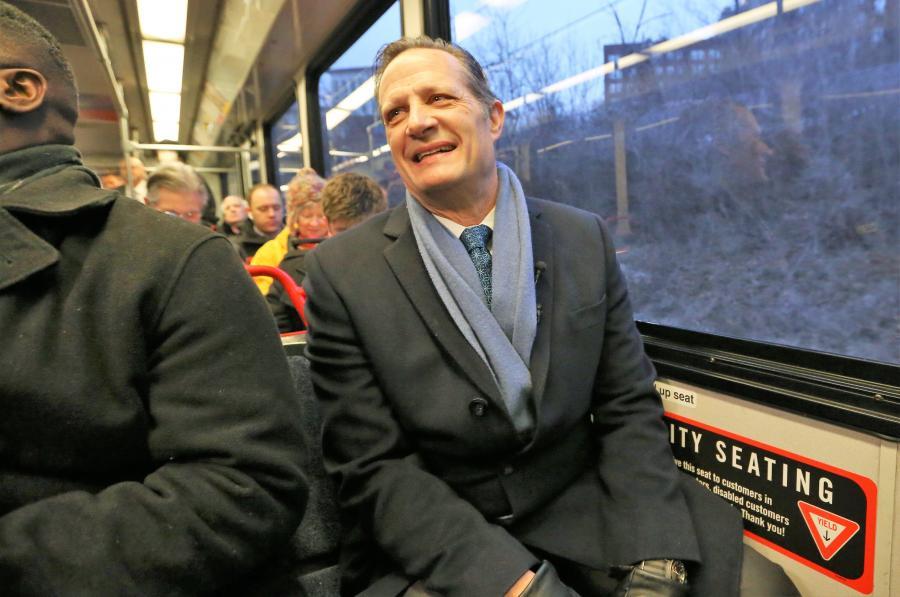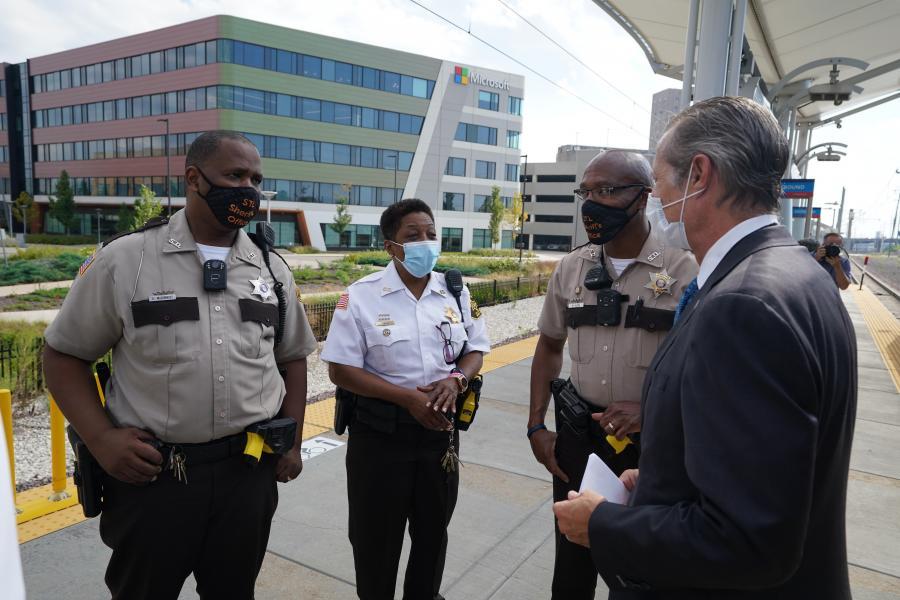
Along with health and safety concerns, the overall economic regional impact of the COVID pandemic is one of the things uppermost in people’s minds.
Taulby Roach, Bi-State Development president and chief executive officer, said there is no question that managing or mitigating the negative effects of COVID-19 is the operative strategy when it comes to local economics.
“Therefore, what we are working to do at Bi-State Development is to create a financial strategy that allows us to essentially push for economic stability through the negative effects of the pandemic,” Roach said. “Ideally, this will allow for us to preserve capacity and anticipate the swing as we move into recovery.”
Bi-State Development promotes economic growth and development in the St. Louis region. As president and CEO, Roach is responsible for several different enterprises that play unique roles in moving people and goods through the Bi-State region – from the Metro Transit system, serving residents in nearly 600 square miles in Missouri and Illinois, the trams that travel to the top of the Gateway Arch, the airport that is the region’s front door for general business aviation, to the freight district that is putting the bi-state area on the map as a global freight logistics hub.
The diverse enterprises that Roach oversees have more than 2,400 employees, and an operational budget of $369 million, collectively. Roach is committed to providing the Missouri-Illinois bi-state area with a world-class transportation system and building a regional foundation for economic development, equity and growth, while working collaboratively with the Bi-State board of commissioners, regional partners and stakeholders.
Roach has 30 years of experience in transportation, real estate, infrastructure and economic development. In his work with the St. Clair County Transit District in Illinois, he served as the organization’s chief financial officer, and led the planning, design, management and execution of numerous capital grant projects, budget and policy initiatives and innovative transit and transportation programs.
He earned his bachelor’s degree in history at Regis University, and his master’s degree in public policy and administration from the University of Missouri. He completed the executives in state and local government certificate program from Harvard University.

Roach is a frequent public transit rider himself and an avid cyclist. He recently told Gazelle about some of the changes and safety measures put in place on public transportation since March, and offered a glimpse into what can be expected as far as economic stability and growth in the region.
What are some of the key approaches to surviving the current economic impact?
Roach: Critical to surviving the pain of the downturn is effective management of financial assets. Specifically, we have taken the approach to dedicate all of our federal relief dollars (for transit – the CARES Act) toward preservation of employment strength. By targeting stabilization of employment and wages, the effects on local consumer strength can be minimized. Additionally, by concentrating the capital infusions directly into employment, there is the added benefit of keeping the dollar effects localized.
What have been some of the biggest challenges right now for Metro Transit as far as safety for travelers and employees, while still getting people – including essential workers – where they need to go?
Roach: I cannot overstate how proud I am of our Metro Transit team and all of our operators and front-line staff for the incredible service they have delivered to the St. Louis region during the pandemic. Since COVID-19 first began to impact the bi-state area in March, our team made significant adjustments to our operations and policies to protect our riders and our team members, while continuing to provide vital transportation options for everyone in the community. The first challenge was establishing new safety protocols to address the pandemic, and the team quickly implemented several changes, including:
- Increasing the frequency of cleaning and disinfecting of transit vehicles and high-touch areas throughout the transit system.
- Using new CDC-approved disinfectants and disinfecting tools, like misters.
- Daily temperature screenings for all employees.
- Requiring face coverings for all riders and employees while on the system.
- Establishing a new touchless mobile fare option and suspending paper fares to eliminate the need to exchange physical tickets and passes.
- Fabrication and installation of polycarbonate shields to protect our MetroBus operators.
- Adjusting service to match ridership levels to maintain safe operations.
When you ride Metro Transit today, you can see firsthand how all of these steps have created an exceptionally clean transit system with masks, social distancing and other guidelines in place that ensure our riders can enjoy a safe, comfortable and convenient transit experience.
The challenge moving forward is ensuring we maintain our vigilance, continue monitoring our operations to see if additional adjustments need to be made, and continue to inform and educate our customers about the guidelines we are following to keep everyone safe. To address that, we continue to convene a special task force of our leadership team, which was first established in March, that regularly analyzes regional health data, transit service information and field operations. This allows us to quickly make adjustments. Secondly, we have joined the American Public Transportation Association on a health and safety program to strengthen our commitment and our communications, and help reinforce all of our safety efforts with our riders and the community.
Tourism has obviously been affected, as well. How have functions changed at the Gateway Arch?
Roach: In March, the decision was made to temporarily suspend tram ride operations to the top of the Gateway Arch, and close the Old Courthouse and the Gateway Arch visitor center, museum and Tucker Theater. The park grounds remained open to the public, but all ticketing and reservations were suspended.
Starting in April, Bi-State Development, the National Park Service and other partners began working on a reopening and recovery plan that required approval from regional and national NPS officials. That plan started to take effect in June, with the reopening of the visitor center and museum at limited capacity, and with the temporary requirement that all visitors have a free timed entry-only ticket in order to control capacity.
On Sept. 1, we were able to reopen the tram rides to the top of the Gateway Arch with limited capacity, one-way travel through the visitor experience, and protocols, including one family or group per tram car. Later in the month, the Tucker Theater reopened with limited capacity to maintain safety. We are seeing the return of strong tourism numbers and visitor demand.

Has there been more utilization of local suppliers and how has that affected freight and airport functions?
Roach: The COVID-19 pandemic has allowed us to really see the resiliency and adaptability of our region’s freight network. In addition to instituting new protocols to keep employees safe, our freight sector has been able to adjust operations to the changes in national and international freight movement as a result of the coronavirus.
Industries like automobile manufacturing had temporary closures and reduced shipping schedules. Imports from China and other international markets were greatly reduced. Our region made adjustments to these shifts. Over-the-road trucking was able to free up trucks normally used for temporarily closed industries to focus on essentials, like groceries, food and medical items. Trucking companies are still busy, and employees concerned for their own safety prefer to come to areas like the St. Louis region over densely populated areas like Chicago or New York.
Our rail network shifted to ensure that medical supplies, food, chemicals, cleaning products and anything else used to battle the pandemic moves through the region efficiently. And our region’s port system continues to see a tremendous amount of freight moving through the bi-state area, handling a high volume of corn, soybeans and other products needed to feed the country and the world.
What do you see as some of the most important projects in the region as we move toward 2021?
Roach: Assuming we are on a post-pandemic trajectory in October 2021, the most important projects for the region should be those aimed at building employment and economic capacity. Several come to mind, like the light rail extension to MidAmerica Airport in St. Clair County, Northside Extension of Transit to North City and County, and the continued progress of the academic and research corridor in the city’s central core. Specifically, I’d note the expansions of the BJC medical campus in conjunction with St. Louis University’s expansion to the south. In fact, you might argue that these excited economic districts are close to becoming one dynamic and continuous urban corridor. The transit expansions bring new possibilities for our region to expand by adding access and opportunity to the burgeoning MidAmerica Airport complex, complemented by Scott Air Force Base. Additionally, a northern expansion of transit has the potential to open more economic opportunity and access to populations of need. In fact, several of our strongest transit routes serve the north-south travel patterns that follow job opportunities. Strengthening these ties is a fundamental part of equitable economic growth.
For more information on Metro Transit and measures that have been put in place for safety during the pandemic, visit metrostlouis.org/health.





